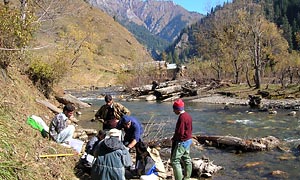An empirically based simulation model to inform flow management for endangered species conservation
Date:
2019 - 2021
Abstract:
Increasing water demand, water development, and on-going climate change have driven extensive changes to the hydrology, geomorphology and biology of arid-land rivers globally, driving an increasing need to understand how annual hydrologic conditions affect the distribution and abundance of imperiled desert fish populations. We analyzed the relationship between annual hydrologic conditions and the endangered Rio Grande silvery minnow in the Middle Rio Grande, New Mexico, USA, using hurdle models to predict both presence and density as a function of integrated annual hydrologic metrics. Both presence and density were positively related to spring high flow magnitude and duration and negatively related to summer drying, as indicated by an integrated flow metric. Simulations suggest hydrologic conditions near the wettest observed in the data set would be required to meet recovery goals in a single year in all reaches. We demonstrate how the models developed herein can be used to examine alternative water management strategies, including strategies that may currently be socially and logistically infeasible to implement, to identify strategies minimizing trade-offs between conservation and other management goals.
Funding:
- U.S. Bureau of Reclamation Upper Colorado Basin - Albuquerque Area Office
- U.S. Geological Survey – Utah Cooperative Fish and Wildlife Unit (in-kind)
- The Ecology Center at Utah State University
Investigators:
- Dr. Tim Walsworth, Dept. of Watershed Sciences, USU
- Dr. Phaedra Budy, U.S. Geological Survey – UCFWRU, Dept. of Watershed Sciences, USU
Other Collaborators:
- Kenneth Richard, Ashlee Rudolph, and Dr. Mark McKinstry, Bureau of Reclamation
- Dr. Charles Yackulic, U.S. Geological Survey – Grand Canyon Research and Monitoring Center

Posterior distributions of parameter estimates for (a) the hydrologic index effect on RGSM presence βp, (b) hydrologic index effect on density βc, (c) global mean baseline (logit) capture probability μα, and (e) global expected asymptotic density μK where the light grey boxes indicate the 95% CI and medium grey boxes indicate the 50% CI. Distribution of reach specific parameter values relative to the global mean for (d) capture probability μα and (f) expected asymptotic density μK, where different letters above boxes indicate significantly different distributions. (g) Time-series of the posterior distribution of the annual values for the latent trend wt.


